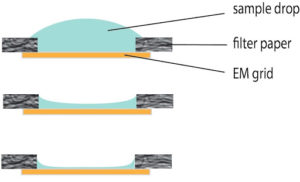APPLICATIONS OF TECHNOLOGY:
- Sample preparation for transmission electron cryomicroscopy (cryo-EM)
BENEFITS:
- Takes the guesswork out of cryoEM sample preparation
- Increases sample prep success rate, and decreases the need to screen repeated trials
- Reduces protein degradation by preventing exposure to air or the air-liquid interface when very thin samples are prepared
- Compatible with the use of affinity grids which bind molecules to the substrate and prevent their denaturation at the air-water-interface
BACKGROUND:
- For cryo-EM of hydrated biomolecules, it is necessary to create a thin sample of vitreous ice containing the molecules of interest. The is most commonly achieved by applying a volume of aqueous solution containing the biomolecules onto the carbon film of an electron microscopy grid and then pressing an absorbent material (e.g., filter paper) against the aqueous solution to remove the majority of the solution before freezing.
TECHNOLOGY OVERVIEW:
Researchers at Berkeley Lab have developed a novel device and method that allows researchers to prepare thin layers of vitreous ice without relying on direct contact of absorbent material with the aqueous film that is to be imaged. This sample prep machine thins the aqueous lubrication layer over the substrate by combining draining with a flow of humid air to push aqueous solution away from the imaging area.
The resulting thin aqueous films can be plunged into a cryogenic solution for vitrification via the typical approach. This device has the potential to improve repeatability, control, and throughput of sample preparation for cryo-EM.
DEVELOPMENT STAGE: Proven principle, functioning device
FOR MORE INFORMATION:
https://pubmed.ncbi.nlm.nih.gov/31952802/
PRINCIPAL INVESTIGATORS:
- Maxim Armstrong
- Robert M. Glaeser
- Daniel A. Fletcher
- Bong-Gyoon Han
STATUS: Patent pending.
OPPORTUNITIES: Available for licensing or collaborative research.
SEE THESE OTHER BERKELEY LAB TECHNOLOGIES IN THIS FIELD:
- Optical-Cavity Phase Plate for Controllable, Stable Phase Shift in TEM and Cryo-EM Applications 2017-080
- Consistent, Reliable Preparation of Cryo-EM Specimens 2015-108
